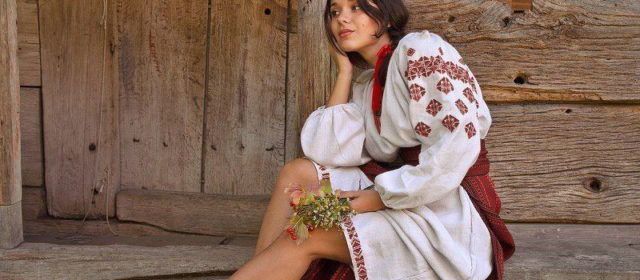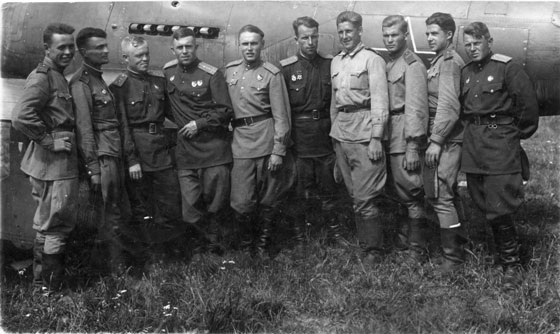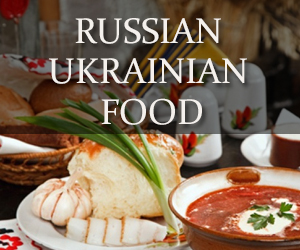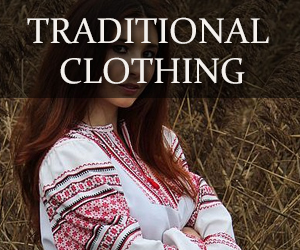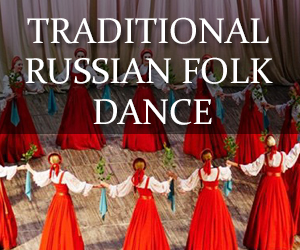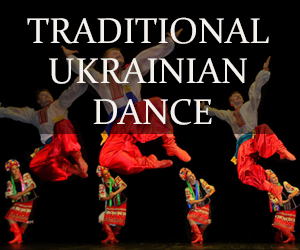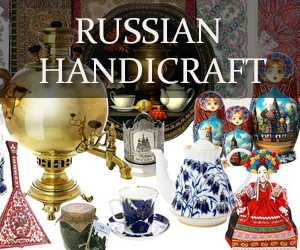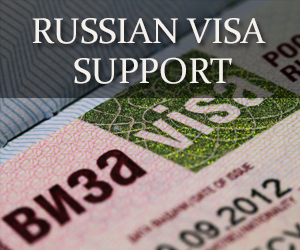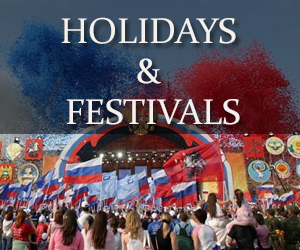Ethnic Russian and Ukrainian clothing is a derivative of both practicality and creativity. Many of the garments associated with Russia and Ukraine were simply founded as the best possible means to stay warm. The fur and sheep skin coat (shuba and dublyonka), warm fur and wool hats (ushanka,papakha and budenovka), as well as the wool felt footwear (valenki), are all extremely practical and effective in a cold northern climate. Even in the 21st century, with the development of new synthetic materials, traditional winter clothing is still the preferred means of Russians and Ukrainians to stay warm in frigid temperatures.
Traditional Russian and Ukrainian clothing also became a means of expression and creativity. From the rich and varied Ukrainian embroidery to the intricate knitting of traditional Russian shawls and scarves, some of the most valued cultural treasures are the result of artistic innovation and imagination being expressed through traditional folk apparel.
Below are descriptions and examples of traditional clothing from Russia and Ukraine.
Russian Fur Coats and Hats
Fur Coats and hats are an important part of Russian clothing and culture. Fur is one fashion apparel that has been in Russia since the beginning, and so long as Russian winters are cold, its a “trend” unlikely to change.
Dublyonka
Another wintertime apparel is the suede, or sheepskin leather jacket known as a dublyonka (дублёнка). Like fur, the natural material provides a layer of warmth and defense from bitterly cold Russian winters.
Ushanka
Derived from the word ushi – уши (ears), the ushanka is a traditional Russian hat with flaps to protect the ears from cold. The ushanka was first introduced to the Soviet Red Army uniform during the 1939 Winter War with Finland – phasing out the Budenovka (see below).
Papakha
Papakha is a traditional wool hat worn by people throughout the Caucasus, including Georgians and Chechens.
Following Russian campaigns in the Caucasus around the middle of the 19th century, the papakha was adopted by the Russian military, first by Cossack cavalry, then by the rest of the Tsar’s cavalry. In 1917 the papakha was dropped from the Red Army uniform due to its association with the Tsar’s army. In 1935 the hat was reinstated as part of the uniform, and 1941 it was reserved exclusively for generals and marshals, symbolizing a high rank.
Valenki
Valenki are traditional Russian winter footwear. Made of wool felt, they are still quite common in villages and with older generations. Valenki are worn by themselves or with rubber galoshes to protect the felt boot from getting wet in warmer temperatures.
Valenki may seem simplistic, but they truly are the best footwear for extreme cold temperatures. Mass produced during the Great Patriotic War, Soviet soldiers could resist minus 40 degree temperatures, while German soldiers (without valenki) were vulnerable to severe frost bite on their toes.
Lapti
An obsolete traditional footwear, lapti are basket woven shoes commonly made from fiber of the birch tree. No longer worn in modern times, today they are a common decorative piece hanging in people’s homes.
Ukrainian Embroidery / National Costume
Traditional folk costume plays an important role in Ukrainian national identity. Distinguished for it’s elegant embroidery and rich motifs that vary region to region, taken on the whole Ukrainian clothing maintains a definitive national style. Typically, traditional shirts and blouses of white are embroidered with red, red-black, or red-blue motifs while the entire costume includes woolen skirts, trousers, belts and aprons, red necklaces, wreaths, ribbons and countless other accessories.
Orenburg Shawl
Shawls have long been a part of Russian fashion, and the most famous of all is the Orenburg Shawl. Made from a blend of silk and indigenous goat fiber, the knitting is so fine that it can literally be pulled through a ring, earning it the nickname – “wedding ring shawl”.
Pavlov Posad Scarves
Like the shawl, the scarf was traditionally an important part of every woman’s attire. A married woman was supposed to keep her head covered, and a colorful scarf was a cherished possession. One textile works that has been producing quality scarves for over two centuries, is in the town of Pavlov Posad. The distinctive scarves, with their vivid floral designs, have long been a symbol of national pride.
Sarafan and Kokoshnik
Sarafan is a Russian dress – long and shapeless. Kokoshnik is the head-dress that accompanies the Sarafan. Together they form a Russian folk costume that was traditional dress for peasant women up until the 20th century. Middle and upper class women were quicker to discard the traditional costume – early in the 18th century – as a consequence of Peter the Great’s efforts to modernize Russia.
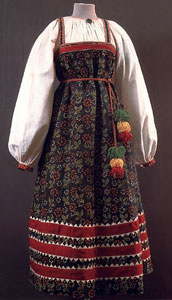
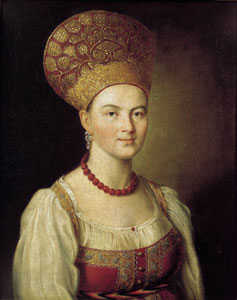
Kosovorotka
Kosovorotka is a traditional Russian shirt commonly worn up to the early 20th century. It has long sleeves and reaches down to the middle thigh. Men traditionally fasten the shirt at the waist with a belt or rope, while women tuck it in their skirt or wear it under the sarafan.

